Construction Materials And Technology: UNIT III: Construction Practices & Service Requirements
Pointing
Types | Construction
Pointing is the process of finishing the exposed joints in the masonry, instead of plastering the entire surface of the masonry. It consists of raking the joints to a depth of 10 mm to 20 mm and filling it with richer mortar mixes.
POINTING
Pointing is the process of finishing the
exposed joints in the masonry, instead of plastering the entire surface of the
masonry. It consists of raking the joints to a depth of 10 mm to 20 mm and
filling it with richer mortar mixes. In case of lime mortar pointing, mix used
is 1 : 2 and in case of cement mortar pointing, mix used is 1 : 3. Pointing is
preferably suited for stone masonry because stones are strong enough and show
good resistance to penetration by water. Pointing gives perfection to joints,
which is the weaker part of masonry. It also gives aesthetic view of the
masonry.
TYPES OF POINTING
During the process of pointing, mortar is
carefully placed in joints using a small trowel. The placed mortar should be of
desired shape. Whenever the fresh mortar is placed in the joints it should be
pressed hardly to gain strong bond with old interior mortar. Different types of
pointing are discussed below:
❖Flush
Pointing: In this type, mortar is pressed hard in the raked joints
and by finishing off flush with the edge of masonry units. The edges are neatly
trimmed with trowel and straight edge. It does not give good appearance. But,
flush pointing is more durable because of resisting the provision of space for
dust and water. Due to this reason, this method is extensively used.
❖Recessed Pointing: In this case, mortar is pressing back by 5mm
or more from the edges. During placing of mortar the face of the pointing is
kept vertical, by a suitable tool. This type gives very good appearance.
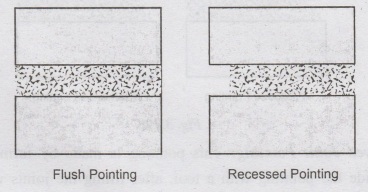
❖Beaded
Pointing: It is formed by steel or ironed with a concave edge. It
gives good appearance, but it will damage easily when compared to other types.
❖ Struck
Pointing: This is a modification of flush pointing in which the face the
pointing is kept inclined, with its upper edge pressed inside the face by 10mm
which drains water easily.
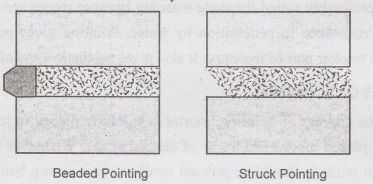
❖ V-Groove Pointing: This is also a modification of flush pointing
in which groove is formed at its mid height, by a pointing tool. V-groove is
formed in the flush-finishing face which gives good appearance.
❖ Weathered
Joint Pointing: As the name suggests, this type of joint
gives adequate protection against weathering. However, it requires a
comparatively large quantity of water.
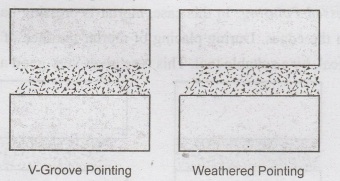
❖ Keyed
Joint Pointing: This pointing is made by forming a
semicircle inside the pointing with a tool, after filling the joints with
mortar. The pointing gives an elegant appearance.
❖ Tuck
Pointing: In this case mortar is pressed in the raked
joint first and is finishing flush with the face. While the pressed mortar is
green, groove or narrow channel is cut in the center of groove which is having
5mm width and 3mm depth. This groove is then filled with white cement putty,
kept projecting beyond the face of the joint by 3 mm. if projection is done in
mortar, it is called bastard pointing or half tuck pointing.
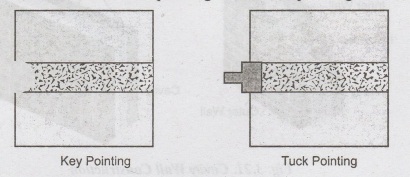
COMPARISON BETWEEN PLASTERING AND POINTING
The following are some of the differences
between plastering and pointing
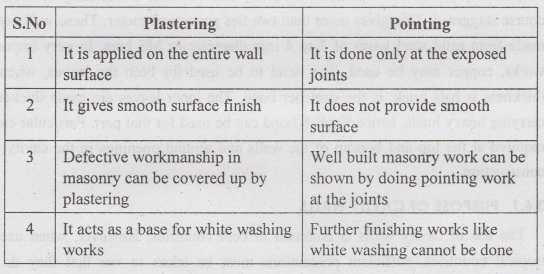
S.No
Plastering
It is applied on the entire wall surface mod,
tot been ad
It gives smooth surface finish
Defective workmanship in masonry can be
covered up by plastering
Further finishing works like works
Pointing
It is done only at the exposed joints
It does
not provide smooth surface
Well
built masonry work can be shown by doing pointing work at the joints
It acts as a base for white washing white
washing cannot be done
Construction Materials And Technology: UNIT III: Construction Practices & Service Requirements : Tag: : Types | Construction - Pointing
Related Topics
Related Subjects
Construction Materials and Technology
CE3302 3rd Semester Civil Dept 2021 Regulation | 3rd Semester Civil Dept 2021 Regulation
